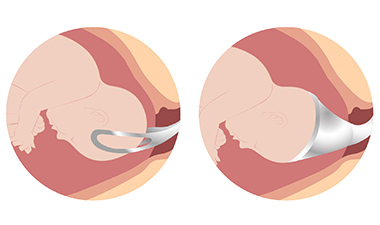Vacuum and forceps-assisted birth
When does delivery require assistance?
Sometimes the mother or baby has trouble in the late stages of labour and assistance is needed to get the baby out. In some cases, help is needed because the baby is not doing well. In others, the mother may have a condition that prevents her from pushing. Sometimes the uterus is not contracting well, or the mother has become too exhausted to effectively push the baby out.
What tools can be used to assist with delivery?
 A trained health care professional can use either a vacuum or forceps to help the baby come out. A vacuum is a plastic cup that uses suction on the baby’s head. Forceps are
A trained health care professional can use either a vacuum or forceps to help the baby come out. A vacuum is a plastic cup that uses suction on the baby’s head. Forceps are
slim, curved, tong-like instruments that slide around the baby’s head inside the birth canal.
Why are vacuum or forceps sometimes used during delivery?
The condition of either the mother or the baby may result in the use of forceps or vacuum during delivery. If the baby is doing poorly, or if the mother has congestive heart failure or cerebral vascular malformations (a tangle of abnormal vessels in the brain), vacuum or forceps can assist the delivery. If the labour is not progressing adequately, this may also be an option. Various other interventions such as one-to-one support, oxytocin, and delayed pushing in women using epidurals decrease the need for vacuum or forceps.
What happens during a vacuum or forceps-assisted birth?
In a vacuum-assisted delivery, the cup of the vacuum is placed on the baby’s head and gentle suction is applied. The health care provider uses the vacuum to assist the mother in moving the baby through the birth canal.
 If your health care provider is going to use forceps, you will usually have some anesthetic, either through an epidural, or a local injection. An episiotomy (an incision between the vagina and the anus) may be needed but is not always necessary. Then, the forceps are inserted on either side of the baby’s head and are used to either turn or gently pull the baby.
If your health care provider is going to use forceps, you will usually have some anesthetic, either through an epidural, or a local injection. An episiotomy (an incision between the vagina and the anus) may be needed but is not always necessary. Then, the forceps are inserted on either side of the baby’s head and are used to either turn or gently pull the baby.
Both of these methods can cause some bruising to the baby’s head. They also are more likely to cause tears to the mother’s vagina or to the pelvic floor. Vacuum and forceps are only used when the baby is quite low in the birth canal to help with the final phase of delivery.

